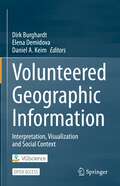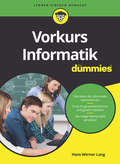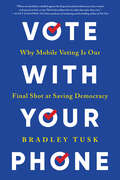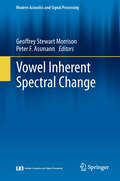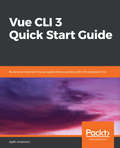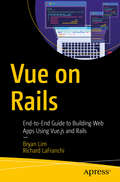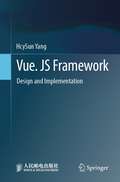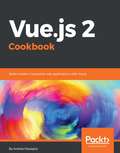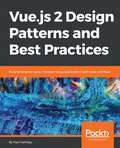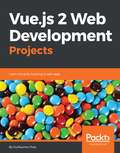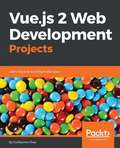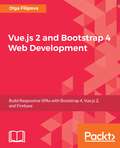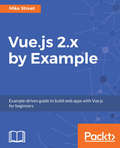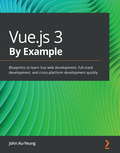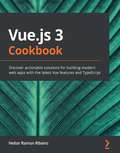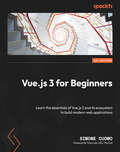- Table View
- List View
Voicing Responsible AI Pedagogy for Music and Visual Arts Education
by Lauri VäkeväThis book critically examines the integration of generative artificial intelligence (Gen AI) in music education, exploring its transformative potential and associated risks. It underscores the necessity for innovative AI pedagogies across music and the arts, offering educators, researchers, and policymakers valuable insights for incorporating Gen AI into teaching while mitigating its hazards. By adopting a balanced critical perspective, the book aims to promote a dynamic, inclusive, and responsible educational approach that is responsive to the rapid advancements in adaptive technology. The book's argumentation is grounded in synthesizing Deweyan pragmatist and Baradian posthumanist philosophical perspectives. These perspectives collectively provide a framework for addressing the deployment of Gen AI in music education within a broader ethical context of global sustainability. The book is also informed by the author's many years as a scholar of music education.
Voltage Regulators for Next Generation Microprocessors
by Toni López Reinhold Elferich Eduard AlarcónThis book deals with energy delivery challenges of the power processing unit of modern computer microprocessors. It describes in detail the consequences of current trends in miniaturization and clock frequency increase, upon the power delivery unit, referred to as voltage regulator. This is an invaluable reference for anybody needing to understand the key performance limitations and opportunities for improvement, from both a circuit and systems perspective, of state-of-the-art power solutions for next generation CPUs.
Volunteered Geographic Information: Interpretation, Visualization and Social Context
by Dirk Burghardt Elena Demidova Daniel A. KeimThis open access book includes methods for retrieval, semantic representation, and analysis of Volunteered Geographic Information (VGI), geovisualization and user interactions related to VGI, and discusses selected topics in active participation, social context, and privacy awareness. It presents the results of the DFG-funded priority program "VGI: Interpretation, Visualization, and Social Computing" (2016-2023).The book includes three parts representing the principal research pillars within the program. Part I "Representation and Analysis of VGI" discusses recent approaches to enhance the representation and analysis of VGI. It includes semantic representation of VGI data in knowledge graphs; machine-learning approaches to VGI mining, completion, and enrichment as well as to the improvement of data quality and fitness for purpose. Part II "Geovisualization and User Interactions related to VGI" book explores geovisualizations and user interactions supporting the analysis and presentation of VGI data. When designing these visualizations and user interactions, the specific properties of VGI data, the knowledge and abilities of different target users, and technical viability of solutions need to be considered. Part III "Active Participation, Social Context and Privacy Awareness" of the book addresses the human impact associated with VGI. It includes chapters on the use of wearable sensors worn by volunteers to record their exposure to environmental stressors on their daily journeys, on the collective behavior of people using location-based social media and movement data from football matches, and on the motivation of volunteers who provide important support in information gathering, filtering and analysis of social media in disaster situations.The book is of interest to researchers and advanced professionals in geoinformation, cartography, visual analytics, data science and machine learning.
Vom Ding an sich zum Internet der Dinge: Löst Künstliche Intelligenz das Problem der subjektiven Erkenntnis? (Die blaue Stunde der Informatik)
by Wolfgang OsterhageSeit Beginn dessen, was man Philosophie nennt – also dem Zeitalter der Vorsokratiker – haben große Geister sich bemüht, den Dualismus Geist-Materie zu überwinden und Erkenntnis auf eine einzige, eindeutige Quelle zurück zu führen – dem Ding-an-sich. Diese Entwicklung wird in diesem Buch nachverfolgt – bis hin zu den modernen Instrumenten der Datenhaltung und der künstlichen Intelligenz. Im Internet of Things schließlich werden Informationen und Objekte wieder zu einer einzigen Entität verschmolzen. Liegt da vielleicht die Lösung nach der Suche des Ding-an-sich?
Von der Fachkraft zum Key-User: Ein Leitfaden zur erfolgreichen Entwicklung von Mitarbeitern in einem ERP-Projekt
by Andreas Niedermeier„ERP Key-User: Die heimlichen Helden der digitalen Transformation&“ ERP-Projekte sind komplex – und der entscheidende Erfolgsfaktor sind die Menschen dahinter. Dieses Buch richtet sich an Mitarbeiter, die sich zum Key-User entwickeln und so maßgeblich zur erfolgreichen Einführung und Optimierung eines ERP-Systems beitragen. Praxisnah, verständlich und direkt umsetzbar zeigt es, wie Key-User Prozesse optimieren, Change-Management meistern und Schnittstellen zwischen IT und Fachabteilungen bilden. Ideal für Unternehmen, die ihre digitale Transformation erfolgreich gestalten wollen. Mit Best Practices, Checklisten und Insider-Tipps aus echten ERP-Projekten bietet dieses Buch alles, was Key-User und Projektverantwortliche wissen müssen. Jetzt Key-User-Kompetenzen aufbauen – für eine reibungslose ERP-Implementierung und nachhaltigen Unternehmenserfolg!
Von der Natur inspirierte intelligente Datenverarbeitungstechniken in der Bioinformatik
by Khalid RazaDieses Buch umfasst und beschäftigt sich mit den jüngsten Fortschritten und modernsten Anwendungen von naturinspirierten Computertechniken (NIC) im Bereich der Bioinformatik und der Computerbiologie, die die medizinischen Wissenschaften bei verschiedenen klinischen Anwendungen unterstützen können. Dieser Sammelband befasst sich mit den grundlegenden Anwendungen, dem Umfang und den Zukunftsperspektiven von NIC-Techniken in der Bioinformatik, einschließlich der Erstellung von Genomprofilen, der Klassifizierung von Genexpressionsdaten, der DNA-Berechnung, der System- und Netzwerkbiologie, der Lösung von Komplikationen bei personalisierten Therapien, der antimikrobiellen Resistenz bei bakteriellen Krankheitserregern und der computergestützten Entwicklung von Arzneimitteln, deren Entdeckung und Therapie. Darüber hinaus wird die Rolle von NIC-Techniken bei verschiedenen Krankheiten und Störungen behandelt, einschließlich Krebserkennung und -diagnose, Brustkrebs, Erkennung von Lungenkrankheiten, Krankheits-Biomarkern und Identifizierung potenzieller Therapeutika.
Von künstlicher Biologie zu künstlicher Intelligenz - und dann?: Die Zukunft unserer Evolution
by Axel LangeHat uns die Evolution als intelligente Menschen ausreichend dafür gerüstet, unsere Zukunft für ein würdiges Leben unserer Kinder und Enkel und für den Erhalt der Erde zu steuern? Der Autor entwickelt Szenarien für die zukünftige Evolution des Menschen. Behandelt werden medizinische und gentechnische Entwicklungen wie Nanotechnologie, Organherstellung im 3D-Drucker, Gehirn-Computer-Schnittstellen, Strategien zur Vermeidung von Pandemien, CRISPR, genetische Verbesserungen, Unsterblichkeit und der Transhumanismus, einschließlich Superintelligenz. Künstliche Intelligenz ist immer im Spiel. Der Mensch nimmt Einfluss auf die Entwicklung alles Lebens, greift damit auch immer stärker in die eigene Evolution ein und überlagert damit die natürliche Selektion und Anpassung. Wir sind nicht mehr an die natürliche Umgebung angepasst, sondern an eine künstliche Welt, die wir selbst schaffen. Aber können wir uns vollständig von der natürlichen Selektion befreien?
Vorkurs Informatik für Dummies (Für Dummies)
by Hans Werner LangMöchten Sie Informatik studieren und sich vorbereiten, um peinliche Wissenslücken zu vermeiden? Dann ist dieses Buch genau das richtige für Sie! Es verschafft Ihnen einen verständlichen und strukturierten Einblick in die Grundlagen der Informatik. Von der notwendigen Mathematik über erste Programmierschritte mit Python und Java bis zu Kryptografie, Datenbanken und Theoretischer Informatik ist alles dabei. Der Autor kennt die typischen Probleme und Verständnishürden der Erstsemester und hilft Ihnen, einen guten Start ins Informatikstudium zu finden. Und dazu brauchen Sie außer Schulmathe und Interesse für Informatik keinerlei Vorkenntnisse. Also los geht?s, starten Sie gut vorbereitet ins Studium.
Vote Gun: How Gun Rights Became Politicized in the United States
by Patrick J. CharlesToday, gun control is one of the most polarizing topics in American politics. However, before the 1960s, positions on firearms rights did not necessarily map onto partisan affiliation. What explains this drastic shift?Patrick J. Charles charts the rise of gun rights activism from the early twentieth century through the 1980 presidential election, pinpointing the role of the 1968 Gun Control Act. Gun rights advocates including the National Rifle Association had lobbied legislators for decades, but they had cast firearms control as a local issue. After the assassination of President John F. Kennedy in 1963 spurred congressional proposals to regulate firearms, gun rights advocates found common cause with states’ rights proponents opposed to civil rights legislation. Following the enactment of the Gun Control Act, lawmakers on both sides of the aisle began to stake out firm positions. Politicians including Richard Nixon and Ronald Reagan recognized the potential of gun control as a wedge issue, and gun rights became increasingly tied to the Republican Party.Drawing on a vast range of archival evidence, Charles offers new insight into the evolution of the gun rights movement and how politicians responded to anti–gun control hardliners. He examines in detail how the National Rifle Association reinvented itself as well as how other advocacy groups challenged the NRA’s political monopoly. Offering a deep dive into the politicization of gun rights, Vote Gun reveals the origins of the acrimonious divisions that persist to this day.
Vote With Your Phone: Why Mobile Voting Is Our Final Shot at Saving Democracy
by Bradley TuskDemocracy is broken because the way we vote is broken. But there is a solution: Mobile Voting.Gun Control. Abortion. From the halls of Congress, it may seem that Americans are bitterly polarized on the biggest policy issues of the day. But Americans are not as divides as we think, and polls show that most of us largely agree on even the most divisive issues. The problem lies in how we vote. Politics is more extreme because only the most extreme voters turn out in primaries. And with politicians prioritizing reelection above all else, they shun compromise, feed this extremism, and get rewarded for it. If a lot more people vote, the views of the electorate become more mainstream, and our politicians and policies will shift to the center. Mobile voting is the solution. We do just about everything on our phones, and yet we still can't use them to vote. But the technology exists, provides enhanced security over traditional paper ballots, and it could exponentially increase voter turnout by: Allowing Americans to vote from anywhere, on their own scheduleMaking voting more accessible for people who are not well served by mail-in ballots, such as voters with visual impairments and military servicemembers – and their families - overseasProviding more security than traditional paper ballotsIncentivizing younger voters to participate by using technology they're familiar withFrom Bradley Tusk, philanthropist and founder of the Mobile Voting Project, comes a deeply informative and timely analysis of our broken voting system, introducing us to the history, opposition, and potential of voting from our devices. Including essays by Martin Luther King Jr. III and other prominent political figures, Vote with Your Phone shows us that a solution to restoring faith in our representative democracy is right in the palm of our hands.
Vote.com
by Dick Morristhis book explains how, by means of the Internet, the Fifth Estate--a new political force--is about to transform American politics. The Fifth Estate is a sort of committee of the whole, made up of all citizens online. The author will probe how the rise of Internet democracy represents the triumph of people's politics over the power of intermediaries, particularly the power of the press and broadcast media, who make up the Fourth Estate. For the first time since the early nineteenth century, the United States is departing from the Madisonian model of representative government to return to Jefferson's radical concept of direct democracy.
Vowel Inherent Spectral Change
by Geoffrey Stewart Morrison Peter F. AssmannIt has been traditional in phonetic research to characterize monophthongs using a set of static formant frequencies, i.e., formant frequencies taken from a single time-point in the vowel or averaged over the time-course of the vowel. However, over the last twenty years a growing body of research has demonstrated that, at least for a number of dialects of North American English, vowels which are traditionally described as monophthongs often have substantial spectral change. Vowel inherent spectral change has been observed in speakers' productions, and has also been found to have a substantial effect on listeners' perception. In terms of acoustics, the traditional categorical distinction between monophthongs and diphthongs can be replaced by a gradient description of dynamic spectral patterns. This book includes chapters addressing various aspects of vowel inherent spectral change (VISC), including theoretical and experimental studies of the perceptually relevant aspects of VISC, the relationship between articulation (vocal-tract trajectories) and VISC, historical changes related VISC, cross-dialect, cross-language, and cross-age-group comparisons of VISC, the effects of VISC on second-language speech learning, and the use of VISC in forensic voice comparison.
Vue 7: From The Ground Up
by Ami Chopine Vladimir ChopineCreate lush terrains and atmospheres in Vue and enhance your knowledge of all the features in this software such as lighting, cameras, and Python scripting. Ami and Vladimir Chopine, from GeetAtPlay.com guide you through 17 stand-alone tutorials, each with a different focus on the key components of Vue. The companion website includes brand new video tutorials from Geekatplay as well as materials, atmosphere settings, image maps, models, project files, and completed images and animations. Vue 7: From the Ground Up is the only book officially certified by e-on software.
Vue CLI 3 Quick Start Guide: Build and maintain Vue.js applications quickly with the standard CLI
by Ajdin ImsirovicBuild Vue apps the right way using Vue CLI 3. Understand how the building blocks of Vue CLI 3 work including npm, webpack, babel, eslint, plugins, GUI, testing, and SCSS. Import third-party libraries and maintain your project.Key FeaturesLearn to work with Vue CLI 3 both on the command line and with a GUIManage VueJS apps, settings, Vue plugins, and third-party libraries Learn how to build Vue apps from scratch using webpack, babel, ES6, vue-router, Jest, Cypress, SCSS, and GitBook DescriptionThe sprawling landscape of various tools in JavaScript web development is becoming overwhelming. This book will show you how Vue CLI 3 can help you take back control of the tool chain. To that end, we'll begin by configuring webpack, utilizing HMR, and using single-file .vue components. We'll also use SCSS, ECMAScript, and TypeScript. We'll unit test with Jest and perform E2E testing with Cypress.This book will show you how to configure Vue CLI as your default way of building Vue projects. You'll discover the reasons behind using webpack, babel, eslint, and other modern JavaScript toolchain technologies. You'll learn about the inner workings of each through the lens of Vue CLI 3. We'll explore the extendibility of Vue CLI with the built-in settings, and various core and third-party plugins.Vue CLI helps you work with Vue components, routers, directives, and services in the Vue ecosystem. While learning these concepts, you'll examine the evolution of JavaScript. You'll learn about use of npm, IIFEs, modules in JavaScript, Common.js modules, task runners, npm scripts, module bundlers, and webpack. You'll get familiar with the reasons why Vue CLI 3 is set up the way it is. You'll also learn to perform linting with ESLint and Prettier.Towards the end, we'll introduce you to working with styles and SCSS. Finally, we'll show you how to deploy your very own Vue project on Github Pages.What you will learnWork with nvm, install Node.js and npm, use Vue CLI 3 with no configuration, via the command line and the graphical user interfaceBuild a Vue project from scratch using npm and webpack, and learn about hot module replacementWork with Babel settings, configurations, and presetsWork with Vue plugins, including testing plugins such as Jest and CypressWrite, run, and watch unit and E2E tests using TDD assertions in the red-green-refactor cycleWork with Vue router and use, nested, lazy-loading, and dynamic routesAdd SCSS to your projects and work with third-party Vue pluginsDeploy your Vue apps to Github PagesWho this book is forThis book is for existing web developers and developers who are new to web development. You must be familiar with HTML, CSS, and JavaScript programming. Basic knowledge of the command line will be helpful but is not necessary.
Vue on Rails: End-to-End Guide to Building Web Apps Using Vue.js and Rails
by Bryan Lim Richard LaFranchiBuild modern and progressive web applications with Vue.js and Ruby on Rails. As the Rails community embraces JavaScript, this book answers your most pressing questions, including how to integrate front-end technologies with Rails, whether to build a single-page application, when and how to use JavaScript in your project, how to scaffold a Vue component in Rails, and how to configure Vue.js in a Rails project. This book explores how to manage and understand priorities when working with Vue on Rails and how to determine the best configuration for your project. You'll see how to reuse your Vue components in a Rails project with less coding and harness the component options, as well as how to use props, events and slots of Vue components. You'll also use webpacker to set up your project and pass data from your Vue component to a Rails controller and back. Finally, you’ll learn which is the best configuration for the router and how to test and deploy your application. These topics are essential for developers and product owners because they cover end-to-end advice for building a web application incrementally or from scratch. Vue.js on Rails shows you just how easy it is to build and maintain a modern web app and save hundreds of hours integrating these two technologies. What You'll LearnUse Vue and Rails together to improve productsBuild a web app with a focus on developer happinessTake a pragmatic approach to web app development with practical code examples Save time configuring Vue and RailsControl and manage states in a Vue on Rails project Who This Book Is For Product owners seeking a technology for a company’s products with an emphasis on development scalability; business owners looking to maximize developer satisfaction and successful product development; technical managers requiring a pragmatic and successful web app development strategy;and new and experienced developers and designers learning to build web apps using the best tools available.
Vue. JS Framework: Design and Implementation
by HcySun YangVue.js, as the Data-driven front-end framework, stands out as one of the mainstream choices for front-end developers. This book provides a detailed introduction of Vue.js framework design principles, including an overview of framework design, response systems, renderers, componentization, compilers, and server-side rendering. Based on Vue.js 3 and strict compliance with the specifications, this book starts from source code with a large number of visual diagrams combined, explaining the implementation of each functional module in Vue.js step by step. By reading this book, developers with hands-on experience with Vue.js 2/3 will be able to further understand the implementation details of Vue.js framework, while front-end developers who are not experienced in vue.js but interested in framework design can quickly grasp the design principle of vue.js.
Vue.js 2 Cookbook
by Andrea PassagliaThis book is for developers who want to learn about Vue.js through practical examples to quickly and efficiently build modern, interactive web applications. Prior experience and familiarity with JavaScript, HTML, and CSS are recommended as the recipes build upon that knowledge. It will also enable both new and existing Vue.js users to expand their knowledge of the framework.
Vue.js 2 Design Patterns and Best Practices: Build enterprise-ready, modular Vue.js applications with Vuex and Nuxt
by Paul HallidayBecome an expert Vue developer by understanding design patterns and the component architecture of Vue.js to write clean and maintainable codeKey FeaturesCraft highly modular applications by exploring design patterns and the component architecture of Vue.jsEnforce a Flux-like application architecture in your Vue.js applications with VuexEasy-to-follow examples that can be used to create reusable code and extensible designsBook DescriptionVue.js 2 Design Patterns and Best Practices starts by comparing Vue.js with other frameworks and setting up the development environment for your application, and gradually moves on to writing and styling clean, maintainable, and reusable Vue.js components that can be used across your application. Further on, you'll look at common UI patterns, Vue form submission, and various modifiers such as lazy binding, number typecasting, and string trimming to create better UIs. You will also explore best practices for integrating HTTP into Vue.js applications to create an application with dynamic data. Routing is a vitally important part of any SPA, so you will focus on the vue-router and explore routing a user between multiple pages. Next, you'll also explore state management with Vuex, write testable code for your application, and create performant, server-side rendered applications with Nuxt. Toward the end, we'll look at common antipatterns to avoid, saving you from a lot of trial and error and development headaches.By the end of this book, you'll be on your way to becoming an expert Vue developer who can leverage design patterns to efficiently architect the design of your application and write clean and maintainable code.What you will learnUnderstand the theory and patterns of Vue.jsBuild scalable and modular Vue.js applicationsTake advantage of Vuex for reactive state managementCreate single page applications with vue-routerUse Nuxt for FAST server-side rendered Vue applicationsConvert your application to a Progressive Web App (PWA) and add ServiceWorkers and offline supportBuild your app with Vue.js by following best practices and explore the common anti-patterns to avoidWho this book is forThis book is for Vue developers who are familiar with framework design principles and utilize commonly found design patterns in developing web applications.
Vue.js 2 Web Development Projects
by Guillaume ChauA project-based, practical guide to get hands-on into Vue.js 2.5 development by building beautiful, functional and performant web applications About This Book • Build exciting real world web projects from scratch and become proefficient with Vue.js Web Development • Take your app to the next level with animation, routing, state management, server-side rendering and i18n • Learn professional web programming techniques to supercharge your Vue.js projects Who This Book Is For If you are a web developer who now wants to create rich and interactive professional applications using Vue.js, then this book is for you. Prior knowledge of JavaScript is assumed. Familiarity with HTML, Node.js, and tools such as npm and webpack will be helpful but not necessary. What You Will Learn • Set up a full Vue.js npm project with the webpack build tool and the official scaffolding tool, vue-cli • Write automatically updated templates with directives to create a dynamic web application • Structure the app with reusable and maintainable components • Create delightful user experiences with animations • Use build tools and preprocessor to make larger professional applications • Create a multi-page application with the official Vue.js routing library • Integrate non-Vue.js elements into your apps like Google Maps • Use the official state-management library to prevent errors • Optimize your app for SEO and performance with server-side rendering and internationalization In Detail Do you want to make your web application amazingly responsive? Are you unhappy with your app's performance and looking forward to trying out ways to make your app more powerful? Then Vue.js, a framework for building user interfaces, is a great choice, and this book is the ideal way to put it through its paces. This book's project-based approach will get you to build six stunning applications from scratch and gain valuable insights in Vue.js 2.5. You'll start by learning the basics of Vue.js and create your first web app using directives along with rich and attractive user experiences. You will learn about animations and interactivity by creating a browser-based game. Using the available tools and preprocessor, you will learn how to create multi-page apps with plugins. You will create highly efficient and performant functional components for your app. Next, you will create your own online store and optimize it. Finally, you will integrate Vue.js with the real-time Meteor library and create a dashboard showing real-time data. By the end of this book you will have enough skills and will have worked through enough examples of real Vue.js projects to create interactive professional web applications with Vue.js 2.5. Style and approach Project-based guide that will help you start building applications immediately with an easy to follow approach. Our book will have 6 concrete projects. It will take readers through clear and logical steps, with screenshots and tips along the way to help you follow the guide and learn how to get more from Vue.js.
Vue.js 2 Web Development Projects
by Guillaume ChauDo you want to make your web application amazingly responsive? Are you unhappy with your app's performance and looking forward to trying out ways to make your app more powerful? Then Vue.js, a framework for building user interfaces, is a great choice, and this book is the ideal way to put it through its paces. This book's project-based approach will get you to build six stunning applications from scratch and gain valuable insights in Vue.js 2.5.
Vue.js 2 and Bootstrap 4 Web Development
by Olga FilipovaLearn how to combine Bootstrap with Vue.js to build responsive web applications. About This Book • Build applications with a good architecture and clean UI with Vue.js and Bootstrap • Understand Bootstrap components and learn to integrate them with the Vue.js structure • Build, deploy, and test your code with various utility tools provided by Vue.js Who This Book Is For This book is for JavaScript programmers who are new to web frameworks and want to start learning it by developing interactive and responsive web applications. What You Will Learn • Create and build web applications using Vue.js, Webpack, and Nuxt.js • Combine Bootstrap components with Vue.js' power to enrich your web applications with reusable elements • Connect the Vuex state management architecture to the Firebase cloud backend to persist and manage application data • Explore the new grid system of Bootstrap 4 along with the far simpler directives in Vue.js • Test Vue applications using Jest • Authenticate your application using Bootstrap's forms, Vue.js' reactivity, and Firebase's authentication API • Deploy your application using Firebase, which provides Backend as a Service In Detail In this book, we will build a full stack web application right from scratch up to its deployment. We will start by building a small introduction application and then proceed to the creation of a fully functional, dynamic responsive web application called ProFitOro. In this application, we will build a Pomodoro timer combined with office workouts. Besides the Pomodoro timer and ProFitOro workouts will enable authentication and collaborative content management. We will explore topics such as Vue reactive data binding, reusable components, routing, and Vuex store along with its state, actions, mutations, and getters. We will create Vue applications using both webpack and Nuxt.js templates while exploring cool hot Nuxt.js features such as code splitting and server-side rendering. We will use Jest to test this application, and we will even revive some trigonometry from our secondary school! While developing the app, you will go through the new grid system of Bootstrap 4 along with Vue.js' directives. We will connect Vuex store to the Firebase real-time database, data storage, and authentication APIs and use this data later inside the application's reactive components. Finally, we will quickly deploy our application using the Firebase hosting mechanism. Style and Approach Step-by-step tutorial
Vue.js 2.x by Example: Example-driven guide to build web apps with Vue.js for beginners
by Bogdan-Alin Bâlc Silva Pablo Henrique Penha Mike StreetKey Features We bridge the gap between "learning" and "doing" by providing real-world examples that will improve your web development skills with Vue.js Explore the exciting features of Vue.js 2 through practical and interesting examples Explore modern development tools and learn how to utilize them by building applications with Vue.js Book Description Vue.js is a frontend web framework which makes it easy to do just about anything, from displaying data up to creating full-blown web apps, and has become a leading tool for web developers. This book puts Vue.js into a real-world context, guiding you through example projects that helps you build Vue.js applications from scratch. With this book, you will learn how to use Vue.js by creating three Single Page web applications. Throughout this book, we will cover the usage of Vue, for building web interfaces, Vuex, an official Vue plugin which makes caching and storing data easier, and Vue-router, a plugin for creating routes and URLs for your application. Starting with a JSON dataset, the first part of the book covers Vue objects and how to utilize each one. This will be covered by exploring different ways of displaying data from a JSON dataset. We will then move on to manipulating the data with filters and search and creating dynamic values. Next, you will see how easy it is to integrate remote data into an application by learning how to use the Dropbox API to display your Dropbox contents in an application In the final section, you will see how to build a product catalog and dynamic shopping cart using the Vue-router, giving you the building blocks of an e-commerce store. What you will learn Looping through data with Vue.js Searching and filtering data Using components to display data Getting a list of files using the dropbox API Navigating through a file tree and loading folders from a URL Caching with Vuex Pre-caching for faster navigation Introducing vue-router and loading components Using vue-router dynamic routes to load data Using vue-router and Vuex to create an ecommerce store
Vue.js 3 By Example
by John Au-YeungExplore the latest Vue 3 features by building high-quality front-end web apps, desktop apps, and full-stack apps using the power of Vuex, Vue Router, and GraphQLKey FeaturesCover the latest features of the Vue 3 ecosystem such as components, prop injection, Vuex, and Vue RouterLeverage Vue’s capabilities for building web apps, mobile apps, and browser gamesExplore the capabilities of Vue Router that make building single-page applications (SPAs) with Vue.js a breezeBook DescriptionVue is one of the leading frameworks with a huge ecosystem and increasing adoption due to its ease-of-use when developing applications and the fact that it can help you achieve impressive results during development quickly. This book explores the latest Vue version – Vue 3.0 - and how you can leverage it effectively.You’ll learn with the help of an example-based approach, starting with the basics of Vue 3 by creating a simple application and exploring features such as components, directives, and their usage. To build your knowledge and enable you to have confidence in your app building skills, the book will show you how to test the app with Jest and Vue Test Utils. Later, you’ll understand how to write non-web apps with Vue 3 and create cross-platform desktop apps with the Electron plugin. You’ll also learn to create a multipurpose mobile app with Vue and Ionic. As you progress, you’ll be able to develop server-side rendered web apps with Nuxt.js that work well with back-end APIs by interacting with GraphQL APIs. Finally, you’ll build a real-time chat app that performs real-time communication using Vue 3 and Laravel.By the end of this book, you’ll have developed the real-world skills you need by working through a range of app-building projects using Vue 3.What you will learnGet to grips with Vue architecture, components, props, directives, mixins, and other advanced featuresUnderstand the Vue 3 template system and create your own directivesUse third-party libraries such as Vue Router for routing and Vuex for state managementCreate GraphQL APIs to power your Vue 3 web appsBuild cross-platform Vue 3 apps with Electron and IonicMake your Vue 3 apps more captivating with PrimeVueBuild real-time communication apps with Vue 3 as the front end and Laravel as the back endWho This Book Is ForThis book is for web developers who are interested in learning front-end web development with Vue 3 and creating professional applications using it. You will also find this book useful if you want to learn how to create full-stack web apps with Vue.js 3.0 as the front end. Prior knowledge of JavaScript programming is required to get the most out of this book.Table of ContentsCreating Your First Application in Vue 3Building a Vue 3 Progressive Web AppBuilding a Slider Puzzle Game with Vue.js 3Building a Photo Management Desktop AppBuilding a Calculator Mobile App with IonicBuild a Vacation Booking App with the PrimeVue UI FrameworkBuilding an E-Commerce Store App with Vue 3 and GraphQLBuilding a Chat App with Vue 3, Laravel, and Socket.io
Vue.js 3 Cookbook: Discover actionable solutions for building modern web apps with the latest Vue features and TypeScript
by Heitor Ramon RibeiroExplore the new features of Vue.js 3 and discover best practices for building fault-tolerant and professional frontend web applications Key Features Migrate your apps from Vue.js 2 to Vue.js 3 with the help of practical recipes Explore the latest Vue.js 3 features such as reactivity API, composition API, and TypeScript support Extend the capabilities and performance of Vue.js apps with Quasar, Vuetify, and Nuxt.js frameworks Book Description Vue.js is a progressive web framework for building professional user interfaces for your web applications. With Vue.js 3, the frontend framework is reinforced with architectural enhancements, new base languages, new render processes, and separated core components. The book starts with recipes for implementing Vue.js 3's new features in your web development projects and migrating your existing Vue.js apps to the latest version. You will get up and running with TypeScript with Vue.js and find succinct solutions to common challenges and pitfalls faced in implementing components, derivatives, and animation, through to building plugins, adding state management, routing, and developing complete single-page applications (SPAs). As you advance, you'll discover recipes to help you integrate Vue.js apps with Nuxt.js in order to add server-side rendering capabilities to your SPAs. You'll then learn about the Vue.js ecosystem by exploring modern frameworks such as Quasar, Nuxt.js, Vuex, and Vuetify in your web projects. Finally, the book provides you with solutions for packaging and deploying your Vue.js apps. By the end of this Vue.js book, you'll be able to identify and solve challenges faced in building Vue.js applications and be able to adopt the Vue.js framework for frontend web projects of any scale. What you will learn Design and develop large-scale web applications using Vue.js 3's latest features Create impressive UI layouts and pages using Vuetify, Buefy, and Ant Design Extend your Vue.js applications with dynamic form and custom rules validation Add state management, routing, and navigation to your web apps Extend Vue.js apps to the server-side with Nuxt.js Discover effective techniques to deploy your web applications with Netlify Develop web applications, mobile applications, and desktop applications with a single code base using the Quasar framework Who this book is for The book is for both new and experienced Vue.js developers looking to overcome challenges in building dynamic web applications with Vue 3. Knowledge of JavaScript and a basic understanding of Vue.js will help you to make the most of this book.
Vue.js 3 for Beginners: Learn the essentials of Vue.js 3 and its ecosystem to build modern web applications
by Simone CuomoGain proficiency in Vue.js 3 and its core libraries, including Pinia, Vue Router, and Vitest, by developing a social media web application with detailed, hands-on instructionsKey FeaturesDiscover best practices for building scalable and performant Vue.js applicationsLearn the basics of component-based architectureFamiliarize yourself with Vue.js core libraries and ecosystemPurchase of the print or Kindle book includes a free PDF eBookBook DescriptionDiscover why Vue.js is a must-learn JavaScript framework for aspiring developers. If you’re a beginner fascinated by Vue.js and its potential, then this book will show you how the progressive and versatile framework can help you build performant applications. Written by an accomplished software architect with over 12 years of experience, Vue.js for Beginners provides a solid foundation in Vue.js and guides you at every step to create a robust social media application, component by component. Starting with a clean canvas using plain HTML and CSS, you’ll learn new topics to build your application incrementally. Beyond the core features, you’ll explore crucial parts of the Vue.js ecosystem, such as state management with Pinia, routing with Vue Router, and testing with Vitest, and Cypress. The structured GitHub repository ensures a smooth transition from one chapter to the next, offering valuable insights into advanced topics, techniques, and recourses. This book is designed to serve as a practical reference guide, allowing you to quickly revisit specific topics when needed. By the end of the book, you’ll have built a strong understanding of Vue.js and be ready to build simple applications effortlessly.What you will learnGain practical knowledge of the Vue.js frameworkDeepen your understanding of Pinia, Vue Router, validation libraries, and their integration with Vue.js applicationsExplore the core concepts of Vue.js, including components, directives, and data bindingCreate scalable, maintainable applications from scratchBuild applications using the script setup and the Composition APIDebug your applications with the Vue debugger toolWho this book is forVue.js for Beginners is for aspiring web developers, students, hobbyists, or anyone who wants to learn Vue.js from scratch and is eager to foray into front-end development using this modern and popular framework. Basic knowledge of HTML, CSS, and JavaScript is required to fully grasp the content of this Vue.js book.


